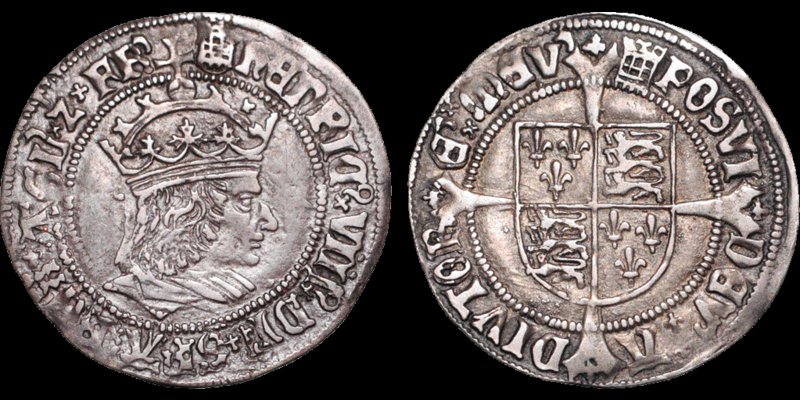Search All Current Lots for Sale:
Printed Auction 37 Aftersale Lot 143

Unique Pattern Groat - Ex Carlyon-Britton
Henry VIII. 1509-1547. AR groat (Unique pattern; Tournai die). 2.82 gm. 26 mm. First Coinage. 1509-1526. London. Crowned portcullis over T / Crowned portcullis i.m (lis in reverse forks). Profile crowned bust of Henry VII right; pellet in field behind head; HENRIC VIII DI GRA REX AGL Z FR; saltire stops; struck from a die originally prepared for Tournai groat / Long cross over shield, lis in forks; POSVI | DEV' x A | DIVTOR | E MEV; double saltire stop between E & M. S. 2316. N. 1762. Stewartby p. 437 (iii). Whitton, p 207 (iii) var. Good Extremely Fine.
Ex Carlyon-Britton. Tag by C.B. describing issue. He considers this a unique pattern.
Cf. BNJ Vol XXVIII (1955-57), p. 203 for R. Carlyon-Britton on this issue.
This piece illustrated on plate XIII accompanying Whitton's article in The British Numismatic Journal, 1950. Whitton notes "It may justly be called a trial piece."
Ex Motcomb (Morton and Eden, 2016).
Tournai, one of Belgium’s oldest cities, sits about fifty miles southwest of Brussels, its history reflecting the forces that flowed back and forth across Europe for centuries. For a while, it was claimed by Henry VIII. England captured it in 1513 in one in the series of Renaissance or Italian Wars. In 1518 the Treaty of London returned the city to French rule.
During those few years of occupancy, English style groats with a Gothic T mintmark were issued at Tournai, though the dies were made at the Tower of London. Few have survived and decent examples show up infrequently.
This group of three coins represents the changeover in coinage and proposed subsequent use of the dies. R. Carlyon-Britton, a major collector and scholar of British coins in the middle of the 20th century, published an article in the 1955-1957 analyzing the re-use of Tournai dies for English issues by overstriking the mintmarks with a portcullis.
Carlyon-Britton considered one of the pieces listed here a pattern. The reverse has a lis in each of the forks and he considered it unique. Whitton agrees calling it “a trial piece.” Stewartby comments that the trefoils may have been to discriminate the Tournai issue from regular Tower issues.
Carlyon-Britton notes that the other coin is known by only one or two other additional examples. Stewartby notes that these coins with an overstruck mintmark are “very rare” but does not address Carlyon-Britton’s numbers.
Such definitive collections as Murdoch and Lockett did not have examples of these overstruck mintmark pieces.
Lot 337 below: The English came back to Tournai beginning with a seventy day siege by the Duke of Marlborough in late June, 1709 during the War of Spanish Succession. The city issued an emergency square siege coinage with the image of Marechal de Surville, city commander.

